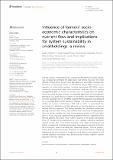Influence of farmers’ socio-economic characteristics on nutrient flow and implications for system sustainability in smallholdings: a review

View/
Date
2023-04-14Author
Mhoro, Lydia
Meya, Akida
Amuri, Nyambilila
Ndakidemi, Patrick
Mtei, Kelvin
Njau, Karoli
Metadata
Show full item recordAbstract
The rise in global human population, coupled with the effects of climate change, has increased the demand for arable land. Soil fertility has been the most affected, among other things. Many approaches to soil fertility management have been proposed by studies in Sub-Saharan Africa (SSA); however, the question of sustainability remains. Nutrient monitoring (NUTMON), which combines biophysical and socio-economic features for soil fertility management, gives an in-situ soil fertility status of a given land use system, which ultimately provides guidance in proposing appropriate soil management techniques in a given land use system. In this review, the Preferred Reporting Items for Systematic Review and Meta-Analysis (PRISMA) approach was deployed for a systematic search of the literature materials. The review evaluated various studies on nutrient monitoring in SSA soils in order to understand the socioeconomic attributes and their influence on farming systems, as well as nutrient flow and balances. The review identified two dominant smallholder farming systems in SSA: mixed crop-livestock and mixed crop farming systems. Also, this review revealed that most nutrient balance studies in SSA have been done in mixed crop and livestock farming systems. However, regardless of the farming systems, the overall mean nutrient balances in all studies, particularly those of nitrogen (N) and potassium (K), were negative, indicating significant nutrient mining. The review further revealed a vast range of biophysical soil fertility management technologies; however, their adoption has been limited by socio-economic aspects including land ownership, gender, financial position, literacy level, and access to inputs. Therefore, in view of this situation, integrating biophysical and socioeconomic disciplines could address the problem of soil nutrient depletion holistically, thus decreasing the existing negative nutrient balances in the SSA region.
URI
https://doi.org/10.3389/fsoil.2023.1112629https://dspace.nm-aist.ac.tz/handle/20.500.12479/1898
